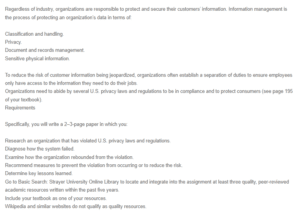Privacy Violations and Corporate Response – A Case of Facebook and Cambridge Analytica
In the age of unlimited internet and data, companies handling personal data must establish mechanisms not to share them with third parties without approval. In the European Union, for example, organizations need to comply with strict guidelines for protecting customer information.
The General Data Protection Regulation (GDPR) has created new standards for consumer rights concerning their data, and compliance is a must. EU’s GDPR is guided by various principles, including fair, lawful, and transparent processing, purpose limitation, data minimization, accuracy, accountability, and data security (4). Again, GDPR applies to every company worldwide that processes personal information.
An organization that violated U.S. privacy laws and regulations.
Several companies have failed to comply with data protection laws. Consequently, third parties have gained the personal information of consumers and used them contrary to the established laws. One such company is Facebook. Following a 16-month investigation, federal officials in America made conclusions that the big tech company repeatedly misled its users and compromised the efforts to protect consumer privacy (1). Cambridge Analytica used third-party applications to gain access to data from a Facebook question that was posed for political purposes.
Following the revelations of the information breach, the Federal Trade Commission fined the company $5 billion for the violations. Presently, the amount is the largest ever imposed on a company for violating consumer data.
Diagnose how the systems failed
Notably, Cambridge Analytica took advantage of Facebook’s terms of service to gain access to their consumer data. The company is touted to have helped Donald Trump ascend to the presidency in 2016, however, Facebook admitted that the technology worked just like it was designed to work.
Interestingly, Facebook provides several tools for software developers are among the popular is Facebook log in. It functions by allowing people to easily log in to an app or website through a Facebook account without creating new credentials. When consumers use Facebook Login, the app’s developer acquires a wide range of information from their profile, including name, friends list, location, and sometimes email.
In 2014, Dr. Aleksandr Kogan, a Cambridge University professor created an app and made use of the company’s login feature and 270, 000 people opted to use the feature (1). With this number, Kogan accessed nearly 50 million personal data information and used it to build psychographic profiles.
How did Facebook rebound from the violation?
The Cambridge Analytica came with severe consequences. Numerous lawsuits, consumer campaigns against Facebook, and loss of revenue because of advertisers pulling ads from Facebook just to mention a few. In general, Facebook’s reputation was damaged.
In truth, Facebook did not intend for the scandal to happen. However, its terms of service worked in favor of a bad actor such as Cambridge Analytica (1). In responding to the scandal, Facebook changed its terms of service to cut down on information accessible to third parties.
Measures to prevent the violation from occurring.
Multiple initiatives can be taken to prevent a future breach of consumer information. Firstly, Facebook must review every app that has access to voluminous data on its platform and any app with suspicious activity (2). Secondly, Facebook can alert any consumer whose information is misused through apps. Thirdly, Facebook can turn off an app’s access to users’ personal data if there’s minimal interaction with the app. Again, Facebook can limit information accessed by third-party applications.
Key lessons learned
Every scandal creates an opportunity to learn key lessons so is the Cambridge Analytica Scandal. For instance, social media users can be easily misled and may be ignorant of what they are contributing or giving away. As such, consumers should be cautious of social media. Again, there are real risks to stakeholder’s privacy (3). Anyone who wishes to use social media to obtain and monitor feedback must be aware of its shortcomings. Besides, any system can be easily gamed by outside influence. In turn, it can influence decisions and policy directions.
References
Isaak, J., & Hanna, M. J. (2018). User data privacy: Facebook, Cambridge Analytica, and privacy protection. Computer, 51(8), 56-59.
Perrin, A. (2018). Americans are changing their relationship with Facebook. Pew Research Center, 5.
Véliz, C., & Grunewald, P. (2018). Protecting data privacy is key to a smart energy future. Nature Energy, 3(9), 702-704.
Stallings, W. (2018). Effective Cybersecurity: A Guide to Using Best Practices and Standards. Pearson Education
ORDER A PLAGIARISM-FREE PAPER HERE
We’ll write everything from scratch
Question 

Privacy Violations and Corporate Response
Regardless of industry, organizations are responsible to protect and secure their customers’ information. Information management is the process of protecting an organization’s data in terms of:
Classification and handling.
Privacy.
Document and records management.
Sensitive physical information.
To reduce the risk of customer information being jeopardized, organizations often establish a separation of duties to ensure employees only have access to the information they need to do their jobs.
Organizations need to abide by several U.S. privacy laws and regulations to be in compliance and to protect consumers (see page 195 of your textbook).
Requirements
Specifically, you will write a 2–3-page paper in which you:
Research an organization that has violated U.S. privacy laws and regulations.
Diagnose how the system failed.
Examine how the organization rebounded from the violation.
Recommend measures to prevent the violation from occurring or to reduce the risk.
Determine key lessons learned.
Go to Basic Search: Strayer University Online Library to locate and integrate into the assignment at least three quality, peer-reviewed academic resources written within the past five years.
Include your textbook as one of your resources.
Wikipedia and similar websites do not qualify as quality resources.